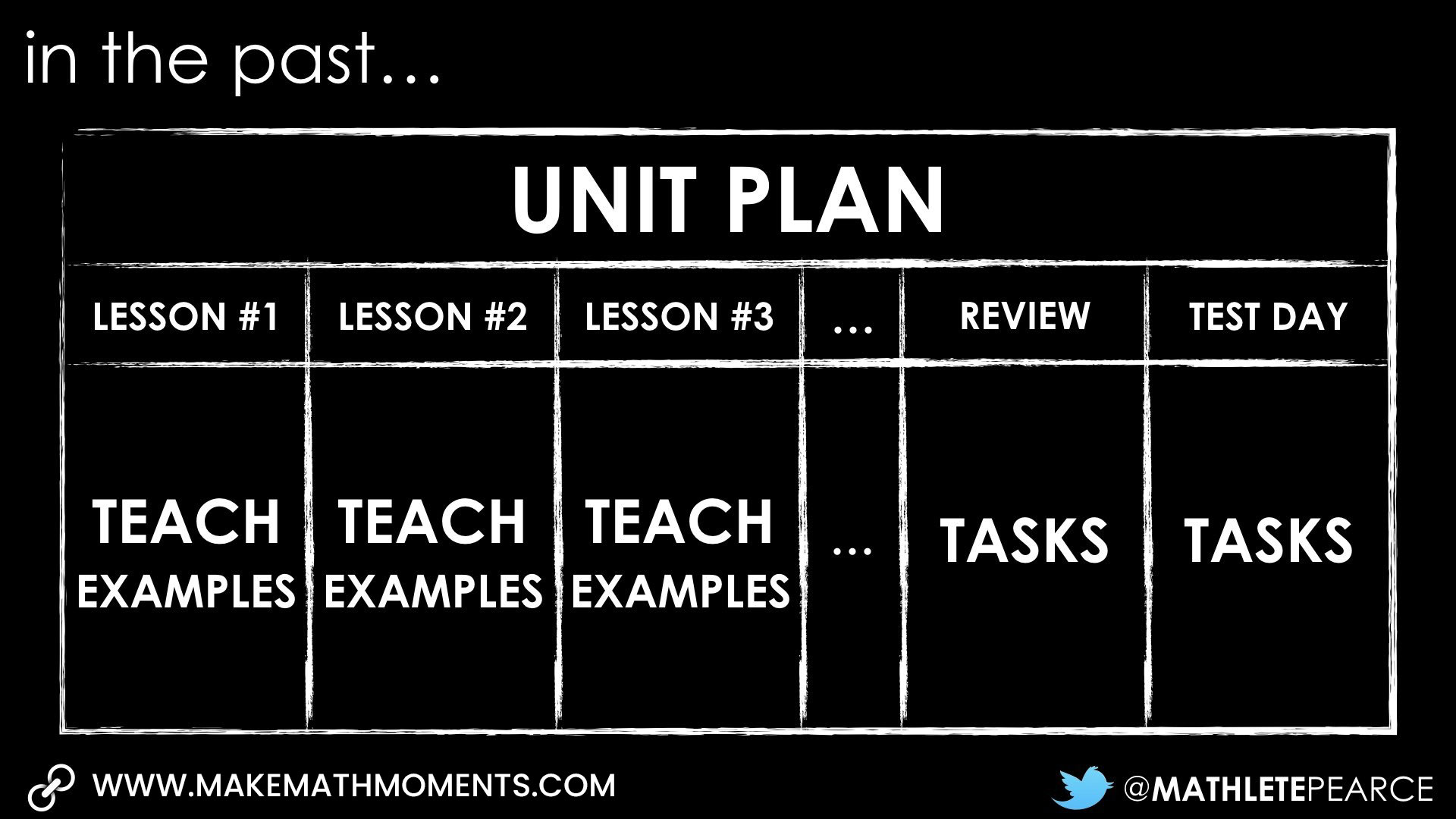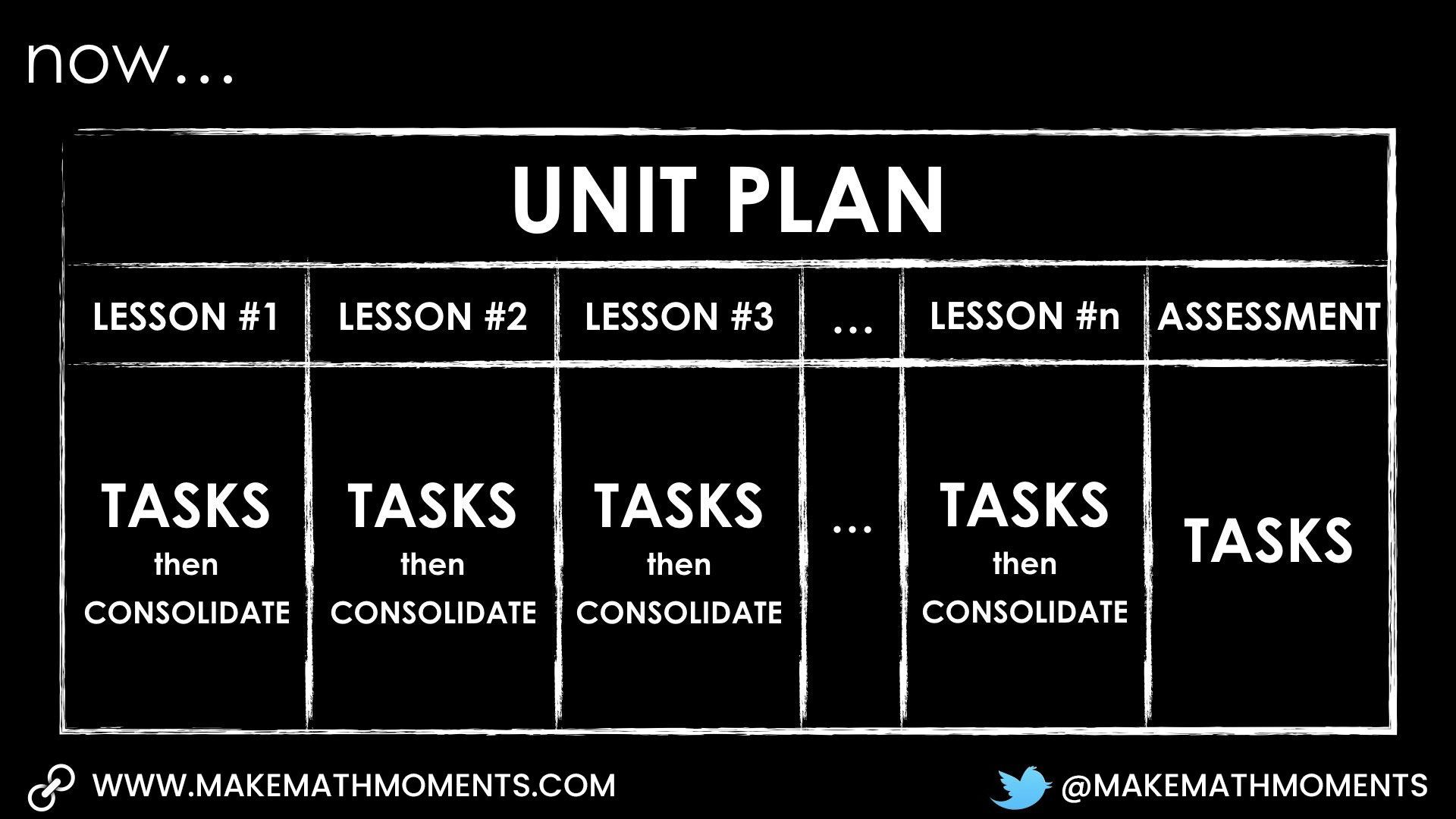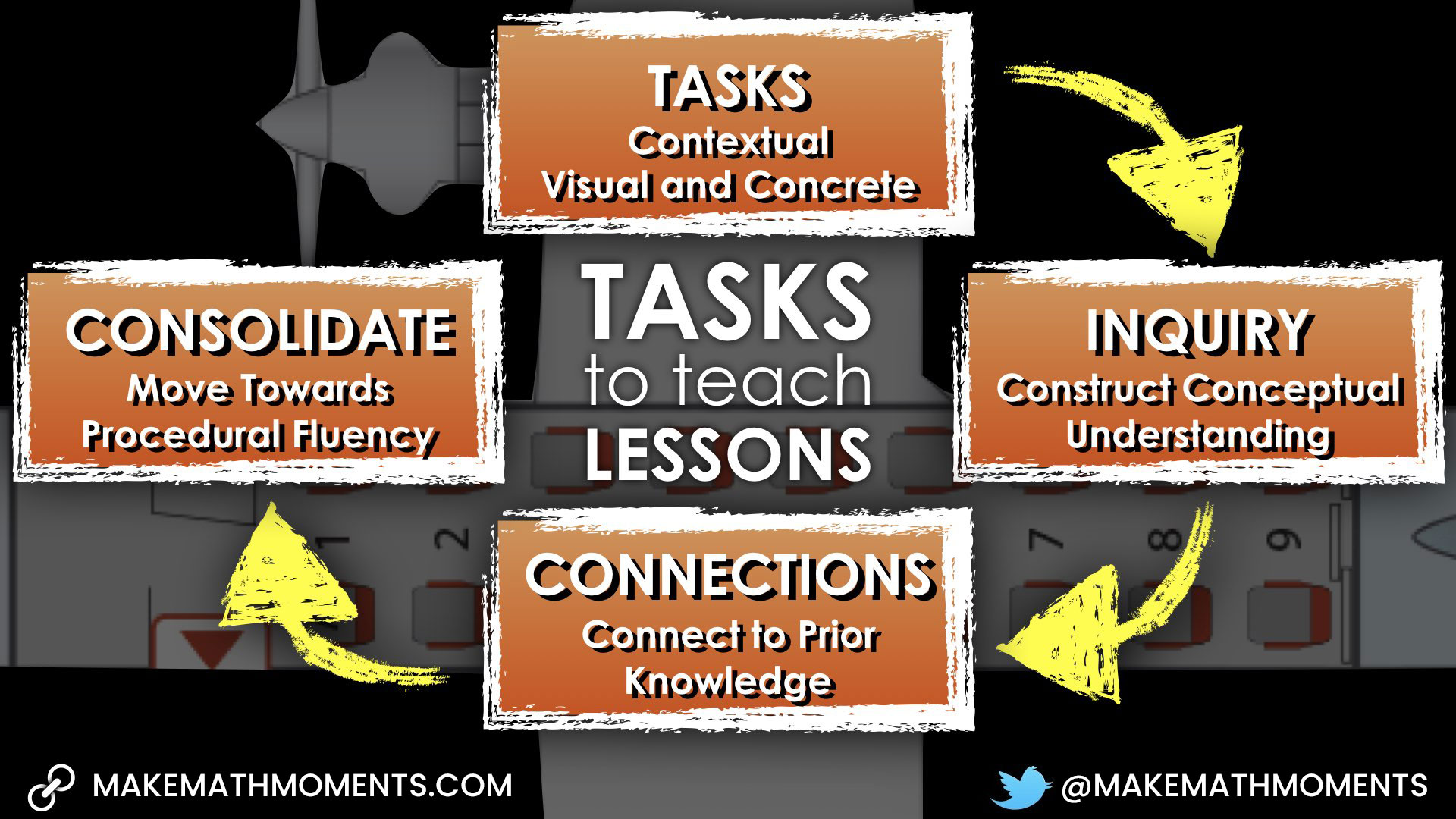Instead of Teaching Lessons to Do Tasks
Over the past 5 years, I’ve been exploring the use of Dan Meyer’s 3 Act Math Task approach in my math classroom and share many of my own tasks when facilitating workshops. After participants experience these tasks in the role of the student, they quickly understand why 3 act math tasks are useful. After their own curiosity is sparked, it would seem reasonable that this type of task protocol would also likely spark curiosity in their students as well. However, what is less obvious to teachers is when they might use a 3 act math task in their classroom.
For some, they want to know when in the unit they should use 3 act math tasks?
- Do I use a 3 act math task once a unit?
- Once a week?
- Everyday?
Then, after deciding when in the unit to use a 3 act math task, the question now becomes when in the lesson should I use the task?
- Do we start with the task at the start of class?
- In the middle after I teach the lesson?
- At the end after I’ve given enough examples?
Because we are all human and humans prefer when decisions in life are black and white, you might be sad to learn that the answer to the above questions is almost always: “it depends”. Since all teachers are unique individuals – just like our students – that means we could (and probably should) have our own thoughts and beliefs around how our own perfect lesson might be delivered.
That said, my intention here is to share some of the ideas that have been developed collaboratively with Jon Orr over the past couple of years around how the structure of our math lessons have changed over time, often involving the use of a 3 act math-style task. Luckily for Jon and I, we were fortunate to have crossed paths at a time when we were both just starting to shift our practice from a largely teacher directed lesson where we would teach at our students to what we might consider more of a teacher facilitated experience where students were at the centre of the learning. We are both very cognizant that this transformation is still a work in progress; however, I’d like to share some of our thinking thus far.
Teaching Lessons to Do Tasks
For the first 7 years or so of teaching, my lessons looked a whole lot like the way I remember math class from my K-12 experience:
- Take Up The Homework: to ensure everybody “got it”
- “Teach” the Lesson: to give definitions, rules, formulae, procedures and algorithms
- Give Examples: in order to show the tips, tricks and common misconceptions
- Assign Practice Problems: to ensure they would be ready for the next day
I would spend hours each evening planning these lessons in order to feel like I was going to give my students the best chance at them succeeding with that concept the next day.
Know what happened?
Some kids still didn’t “get it”.
Don’t get me wrong, I always had a group of students who were well on their way, but I think they would have been fine regardless of how I delivered the lesson.
It was the group of students who “didn’t get it” that I was concerned about.
How could I reach them?
Trying to Use 3 Act Math Tasks in a Teacher Directed Lesson
It wasn’t until I came across Dan Meyer and 3 act math tasks that I began shifting my thinking about how I delivered my math lesson. You’ll notice that in the previous sentence I intentionally avoided using the word “taught”, because I now know that I can’t “teach” my students math, but rather create the conditions where students can construct their understanding of the learning goal I have set out for them each day. This is where I see rich tasks like those using a 3 act math structure can be extremely helpful.
When I first began using 3 act math tasks, I thought that these tasks could only be used after I “taught” students everything they needed to solve the problem. In the first couple of years, this would have been at the end of a unit – maybe on review day – and I thought that I only had “time” to use 1 or 2 per unit of study. Despite the large amount of time and effort I put into seeking out these tasks, planning how I would “fit them in” and figuring out how to best deliver them in class, the response from students wasn’t much better than that of any old task I would typically use from the textbook.

I know some of the reasons the tasks flopped had to do with poor delivery; I wasn’t very smooth due to my lack of practice and I was also missing some key elements like giving students time to notice and wonder. However, I now realize that the biggest problem I created in my math class was my pre-teaching of all the math throughout the unit and waiting to ask students to do any of thinking until review day. By then, students were lost in a sea of disjointed mathematical ideas, rules, formulae, steps and procedures that they hadn’t yet conceptualized because I hadn’t provided them with the opportunity to construct that understanding.
Doing Tasks to Teach Lessons
Now, I’ve come to realize that I can use rich tasks delivered in 3 acts to spark curiosity in order to fuel sense making around a new mathematical idea. Rather than pre-teaching all of the math, let’s use tasks to create a need for the math.

The best part is that most 3 act math tasks can be used to fuel the sense making of many different mathematical ideas.
Consider the act 1 video from the Airplane Problem, for example:
- subitizing,
- early multiplication using arrays,
- distributive property,
- order of operations,
- algebraic expressions,
- and many more!
By avoiding the urge to pre-teach all of the most efficient strategies we math teachers believe students should know how to do, we allow for students to use their prior knowledge as a way to help us assess where they are and where our teaching of the new learning goal should begin that day while consolidating the task. After the consolidation is when I can then shift into teacher directed mode if necessary to address any misconceptions, specifically target gaps in prior knowledge, and build on student solutions to press them for deeper understanding and more efficient and/or effective strategies.

So When Should I Use a 3 Act Math Task?
So while I think the answer to “when should I use a 3 act math task” is still “it depends”, I truly believe we should at least consider using a 3 act math task approach to introducing new mathematical ideas as often as possible. For some, that might mean once a week, while for others that could be once a day; it really does depend. I might also recommend changing your definition of what a 3 act math task is and what makes them so great. For me, the key is finding ways to spark curiosity with tasks as a means to fuel sense making around a new mathematical idea. These really interesting tasks can definitely be your typical 3 act task with a great act 1 video and act 3 “solution” video, but I’m learning more and more each day that the video itself is not what makes them awesome.
It’s so much more than that.
Check back to the blog for more on this topic as we dive deeper in future posts.

Thanks for quoting, “It depends”, otherwise I would be lost. It does look like trial and error teacher to teacher. Also, the frequency is “depending” also teacher to teacher. As a teacher willing to try this method after more than 20 years of classroom teaching, I see prep heavy before presenting.